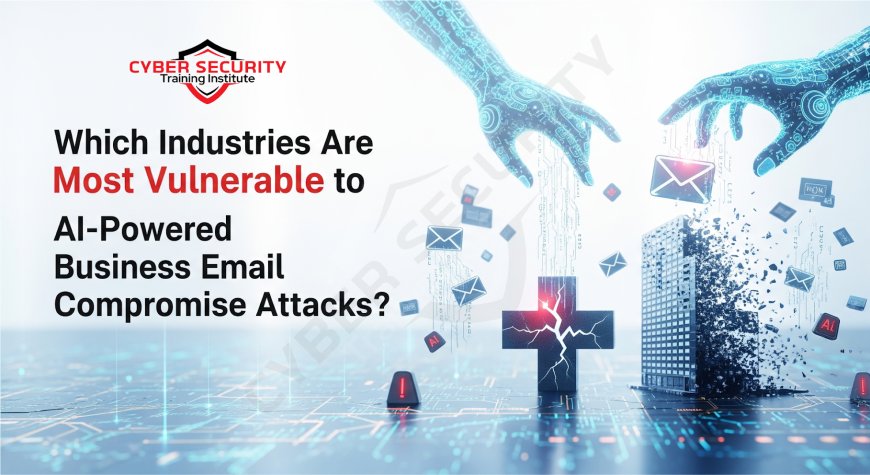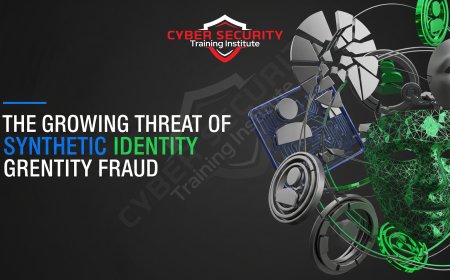Which Industries Are Most Vulnerable to AI-Powered Business Email Compromise Attacks?
The industries most vulnerable to AI-powered Business Email Compromise (BEC) attacks are those with complex supply chains, frequent high-value wire transfers, and decentralized payment authority. Key sectors in 2025 include Manufacturing, Real Estate, Legal Services, and Financial Services. This detailed analysis explains why certain industries have become prime targets for the most financially damaging cyber-attack of the AI era. It contrasts traditional BEC with modern, AI-crafted impersonations that use flawless language and even deepfake voice clones to deceive employees. The article breaks down the attacker's playbook, details the specific scenarios targeting each vulnerable sector, and outlines a multi-layered defensive strategy for CISOs that combines AI-powered email security (ICES) with ironclad business process controls.

Table of Contents
- Introduction
- The Simple Spoof vs. The AI-Crafted Impersonation
- The Perfect Storm: Why AI-BEC is the Top Financial Threat
- Anatomy of an AI-Powered BEC Attack
- Most Vulnerable Industries to AI-BEC Attacks (2025)
- Process, Not Technology: The Root Vulnerability
- The AI Defense: Fighting Impersonation with Identity and Intent
- A CISO's Guide to Building BEC Resilience
- Conclusion
- FAQ
Introduction
The industries most vulnerable to AI-powered Business Email Compromise (BEC) attacks are those with complex supply chains, frequent high-value wire transfers, and decentralized payment authority. In 2025, the key sectors consistently falling victim to these highly sophisticated social engineering attacks include Manufacturing, Real Estate and Construction, Legal Services, and Financial Services. This is because the normal, day-to-day business operations within these industries create the perfect cover for attackers to insert fraudulent financial requests. With Generative AI making impersonations of CEOs, CFOs, and vendors flawlessly convincing, these sectors have become the primary targets for what is now the most financially damaging type of cyber-attack.
The Simple Spoof vs. The AI-Crafted Impersonation
A traditional BEC attack was often recognizable if you knew what to look for. It might involve a simple "display name" spoof, where the email address was clearly wrong, or contain awkward phrasing and grammatical errors that hinted at a non-native-speaking attacker. The defense was to train employees to spot these simple red flags.
The AI-crafted impersonation of 2025 is in a different league. Attackers now use Large Language Models (LLMs) to power their attacks. An AI can be trained on an executive's public communications—such as interviews, blog posts, and shareholder letters—to learn their exact writing style, tone, and vocabulary. The resulting email is not just grammatically perfect; it sounds exactly like the person it is impersonating. This AI-generated lure is often paired with a hyper-realistic deepfake voice clone, used to leave a brief, confirming voicemail for the finance employee, completely neutralizing any suspicion.
The Perfect Storm: Why AI-BEC is the Top Financial Threat
BEC has exploded into the most significant financial threat for businesses for a combination of reasons:
The Power of Generative AI: As detailed, AI makes perfect impersonation scalable and accessible to a wider range of threat actors.
The Attack is "Payload-less": A BEC email contains no malicious links to block or malware attachments to scan. It is just text. This makes it invisible to traditional email security gateways that are focused on finding malicious payloads.
It Exploits People and Processes: The attack doesn't target a technical vulnerability in a firewall; it targets the human vulnerability of trust and flawed internal financial processes. A sense of urgency and the authority of an executive are powerful psychological tools.
Direct, Irreversible Payout: Unlike a ransomware attack that requires a complex negotiation, a successful BEC attack results in a direct, often irreversible wire transfer of funds straight into an attacker-controlled account.
Anatomy of an AI-Powered BEC Attack
Understanding the modern BEC kill chain is critical for building a defense:
1. Executive Reconnaissance: The attacker's AI scrapes the internet for information on a target executive (e.g., the CFO). It gathers data on their writing style, key business partners, and even their travel schedule from social media to know when they are likely to be unavailable for verification.
2. The AI-Crafted Lure: The attacker's LLM generates a highly convincing email that impersonates the executive. The email is sent to a target in the finance department and typically involves an urgent, confidential request, such as, "I'm about to close a secret acquisition and need you to immediately wire the initial deposit to this law firm. This must be kept completely confidential until the deal is announced."
3. Deepfake Voice Confirmation (Optional but Increasing): To add a powerful layer of authenticity, the attacker uses an AI voice clone of the executive to leave a brief voicemail for the target: "Hi, it's [the CFO]. Just following up on my email. This M&A deal is critical, please process that wire transfer as soon as possible. I'm heading into a meeting now. Thanks."
4. Fraudulent Transfer and Disappearance: The finance employee, convinced by the flawless email and the confirming voicemail, bypasses normal procedures and executes the wire transfer. The funds are quickly moved through a series of mule accounts and converted to cryptocurrency, making them nearly impossible to trace or recover.
Most Vulnerable Industries to AI-BEC Attacks (2025)
While any organization is a potential target, attackers consistently focus on these sectors where the business context makes BEC attacks more likely to succeed:
| Vulnerable Industry | Key Business Characteristic | Why It's a Target | Common AI-BEC Scenario |
|---|---|---|---|
| Manufacturing | Complex global supply chains with hundreds of international vendors. | Frequent, large-value wire transfers to a diverse and constantly changing set of suppliers are a normal part of business. A fraudulent invoice is less likely to stand out. | An AI impersonates a legitimate, long-term supplier and sends a perfectly worded email informing the accounts payable team of their "new" bank account details. |
| Real Estate & Construction | High-value, time-sensitive transactions involving multiple third parties (lawyers, title companies, contractors). | Large sums of money are moved for property closings or contractor payments, often under tight deadlines, creating a sense of urgency that attackers exploit. | An AI impersonates the real estate agent or title company on the day of a property closing and sends last-minute, fraudulent wire instructions to the buyer. |
| Legal Services | Regularly handles large client fund transfers and deals with highly confidential M&A activity. | The very nature of legal work involves confidentiality and the movement of large sums of money, making requests for secret, urgent transfers seem plausible to employees. | An AI impersonates a senior partner and instructs a junior associate or paralegal to process an "urgent and confidential" wire transfer related to a supposed client settlement. |
| Financial Services (VC, PE) | Frequent, time-sensitive capital calls and portfolio company investments. | The fast-paced nature of venture capital and private equity means that large, urgent wire transfers are a routine part of closing investment deals. | An AI impersonates the CEO of a portfolio company and sends a fraudulent capital call request to the fund's CFO, or impersonates a General Partner to trick a Limited Partner. |
Process, Not Technology: The Root Vulnerability
It is crucial for leaders to understand that at its core, a successful BEC attack is not a technology failure; it is a business process failure. The attacker is not exploiting a zero-day vulnerability in your firewall. They are exploiting the lack of a mandatory, non-negotiable process for out-of-band verification of any request that involves a financial transaction or a change to payment details. The attack succeeds when a well-meaning employee, under pressure from a seemingly urgent request from an authority figure, feels compelled to skip the critical verification step. Technology can help detect the lure, but only a robust and well-enforced business process can be the ultimate failsafe.
The AI Defense: Fighting Impersonation with Identity and Intent
Just as attackers use AI to craft their lures, defenders must use AI to detect them. The most effective defense is an **Integrated Cloud Email Security (ICES)** platform that uses its own AI models to spot the signs of BEC:
Social Graph Analysis: The defensive AI learns the normal communication patterns of the entire organization. It can immediately flag that an email from the "CEO" is coming from a new, external email address that has never been used before, or that the request is being sent to an employee the CEO has never previously contacted.
Natural Language Understanding (NLU): The AI is trained to understand the linguistic "tells" of a BEC attack. It analyzes the text for an unusual sense of urgency, the use of phrases like "are you at your desk?", requests for secrecy, and the specific language of wire transfers, even if the email comes from a legitimate, compromised account.
Reputation and History: The platform can see that a domain in the reply-to address was registered only yesterday, a massive red flag that a simple human user would likely miss.
A CISO's Guide to Building BEC Resilience
Defending against AI-powered BEC requires a multi-layered strategy that combines technology, process, and people:
1. Implement an AI-Powered ICES Solution: Layer a specialized, API-based email security platform over your existing cloud email. This is the single most important technical control for detecting sophisticated, payload-less BEC attacks.
2. Enforce a Non-Negotiable Verification Process: This is the most critical process control. Mandate that *any* request for a wire transfer, a change in payment details, or the sharing of sensitive data *must* be verified via an out-of-band method, such as a phone call to a pre-registered, known-good phone number.
3. Conduct Continuous, Realistic Training: Your security awareness training must be updated for the AI era. Use a platform that can send employees realistic, AI-generated BEC and deepfake voice phishing simulations to train them on these modern social engineering tactics.
4. Clearly Tag External Emails: Configure your email system to automatically apply a clear, visible "[EXTERNAL]" tag to the subject line of all emails that originate from outside your organization. This helps to break the illusion of an impersonated executive.
Conclusion
AI-powered Business Email Compromise is the apex predator of social engineering attacks, blending flawless impersonation with the exploitation of human psychology and flawed business processes. While industries like manufacturing, real estate, and legal services are particularly vulnerable due to the nature of their financial transactions, every organization that moves money is a potential target. The defense must therefore be as multi-layered as the attack is sophisticated. It requires the latest in AI-powered email security technology to detect the subtle signs of impersonation, combined with the timeless and fundamental security control of an ironclad financial verification process and a well-trained, perpetually skeptical workforce.
FAQ
What is Business Email Compromise (BEC)?
BEC is a sophisticated scam targeting businesses, where an attacker impersonates a high-level executive or a trusted vendor to trick an employee into making a wire transfer or divulging confidential information.
How is AI being used in BEC attacks?
Attackers use Generative AI (specifically, LLMs) to write perfectly worded, grammatically correct, and highly convincing impersonation emails. They can even use AI voice clones to leave confirming voicemails.
What is the difference between BEC and regular phishing?
Regular phishing is often a high-volume, generic attack that uses a malicious link or attachment. BEC is a highly targeted, low-volume spear-phishing attack that is often "payload-less" (containing only text) and relies purely on social engineering.
Why is the manufacturing industry so vulnerable?
Because manufacturers deal with a large, complex, and often international supply chain. This means that frequent wire transfers to a diverse set of vendors are a normal and expected part of business, making it easier for a fraudulent invoice to blend in.
What is a "payload-less" attack?
This is an attack that does not contain any malicious files or links for a security tool to block. The entire "payload" is the socially engineered text of the email itself.
What is a deepfake voice clone?
It is an AI-generated, synthetic replica of a person's voice. With just a small sample of a person's real voice (e.g., from a YouTube video or earnings call), an attacker can create a model that can be used to make it sound like that person is saying anything.
What is an Integrated Cloud Email Security (ICES) platform?
ICES is a modern email security solution that connects directly to cloud email platforms (like M365) via API. This gives it the visibility needed to analyze communication patterns and detect BEC attacks that traditional gateways miss.
What is "out-of-band" verification?
It is the process of verifying a request using a different communication channel than the one the request was received on. For example, if you receive an urgent email request for a wire transfer, you would verify it by making a phone call to the sender's known, trusted phone number.
Why are legal firms targeted?
Legal firms are targeted because they routinely handle large sums of client money for things like property closings and legal settlements. The high-pressure, confidential nature of their work makes their employees susceptible to urgent, secret requests.
What is "CEO fraud"?
This is another common name for a BEC attack, specifically one where the attacker impersonates the organization's Chief Executive Officer (CEO).
Can an AI defense really stop a BEC attack?
Yes. An AI-powered ICES platform can detect a BEC attack even if it comes from a legitimately compromised account. It does this by analyzing the language of the request (e.g., for urgency and financial terms) and the communication pattern (e.g., this person has never emailed the finance department before) to spot anomalies.
What is a "social graph" in email security?
A social graph is an AI-generated map of the normal communication patterns within an organization. It understands who typically emails whom, how often, and at what times, and uses this baseline to detect unusual or anomalous communications.
How do attackers get samples of a CEO's writing style?
They can easily find them in publicly available sources, such as shareholder letters, company blog posts, press releases, and published interviews.
What is a money mule?
A money mule is a person who transfers illegally obtained money on behalf of a criminal. The fraudulent wire transfers in BEC attacks are sent to accounts controlled by money mules, who then quickly move the money to make it harder to trace.
Are smaller businesses at risk?
Yes, absolutely. Criminals often target small and medium-sized businesses because they are less likely to have sophisticated technical defenses and formalized financial processes in place.
What does it mean to "tag" external emails?
It is a simple but effective security control where your email system automatically adds a visual warning, like an `[EXTERNAL]` tag, to the subject line of any email that comes from outside your company. This helps remind employees to be cautious, even if the display name looks like it's from an internal executive.
Why is real estate a target?
The real estate transaction process involves large, time-sensitive wire transfers between multiple parties (buyers, sellers, agents, title companies). This creates a target-rich and high-pressure environment that is ideal for attackers to exploit.
What is the most important defensive step?
While technology is important, the single most critical defense against BEC is a non-negotiable, enforced business process for out-of-band verification of all financial transactions. Technology can fail, but a strong process can be a final failsafe.
How can I train my employees for this?
Use a modern security awareness training platform to send your employees regular, realistic phishing simulations. The best platforms can now use AI to craft BEC-specific scenarios to test and train your employees on this exact threat.
What should I do if I think I've fallen for a BEC scam?
You must act immediately. Contact your bank and the recipient's bank to report the fraudulent transfer and request a recall of the funds. The sooner you act, the higher the chance of recovery. You should also report the incident to law enforcement.
What's Your Reaction?
 Like
0
Like
0
 Dislike
0
Dislike
0
 Love
0
Love
0
 Funny
0
Funny
0
 Angry
0
Angry
0
 Sad
0
Sad
0
 Wow
0
Wow
0
















